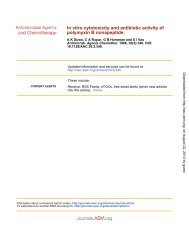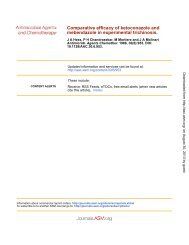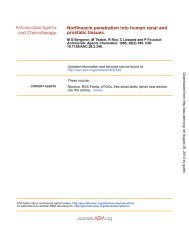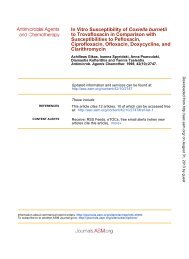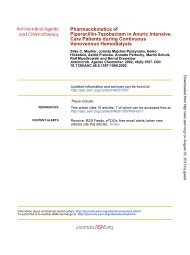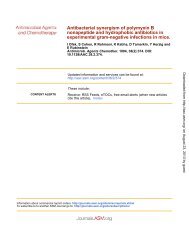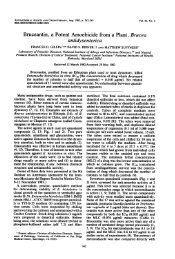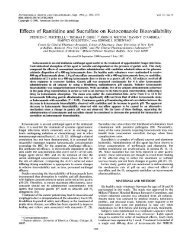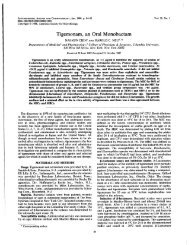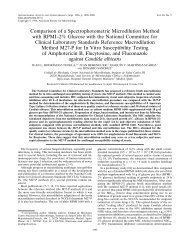cyp51A-based mechanisms of Aspergillus fumigatus azole drug ...
cyp51A-based mechanisms of Aspergillus fumigatus azole drug ...
cyp51A-based mechanisms of Aspergillus fumigatus azole drug ...
Create successful ePaper yourself
Turn your PDF publications into a flip-book with our unique Google optimized e-Paper software.
AAC Accepts, published online ahead <strong>of</strong> print on 13 May 2013<br />
Antimicrob. Agents Chemother. doi:10.1128/AAC.00167-13<br />
Copyright © 2013, American Society for Microbiology. All Rights Reserved.<br />
1<br />
2<br />
3<br />
4<br />
5<br />
6<br />
7<br />
8<br />
9<br />
10<br />
11<br />
12<br />
13<br />
14<br />
15<br />
16<br />
17<br />
18<br />
19<br />
20<br />
21<br />
22<br />
23<br />
24<br />
25<br />
26<br />
27<br />
28<br />
29<br />
30<br />
31<br />
32<br />
<strong>cyp51A</strong>-<strong>based</strong> <strong>mechanisms</strong> <strong>of</strong> <strong>Aspergillus</strong> <strong>fumigatus</strong> <strong>azole</strong><br />
<strong>drug</strong> resistance present in clinical samples from Germany<br />
Oliver Bader* 1 , Michael Weig 1 , Utz Reichard 1 , Raimond Lugert 1 , Martin Kuhns 1 , Martin<br />
Christner 2 , Jürgen Held 3 , Silke Peter 4 , Ulrike Schumacher 4$ , Dieter Buchheidt 5 , Kathrin<br />
Tintelnot 6 , Uwe Groß 1 , and MykoLabNet-D § partners<br />
1<br />
Institute for Medical Microbiology and German National Reference Centre for Systemic<br />
Mycoses, University Medical Center Göttingen, Kreuzbergring 57, 37075 Göttingen,<br />
Germany<br />
2<br />
Department for Medical Microbiology, Virology and Hygiene, University Medical Clinic<br />
Hamburg-Eppendorf, Martinistraße 52, 20246 Hamburg<br />
3<br />
Institute for Medical Microbiology and Hygiene, University Medical Center Freiburg,<br />
Hermann-Herder-Straße 11, 79104 Freiburg<br />
4<br />
Institute <strong>of</strong> Medical Microbiology and Hygiene, University <strong>of</strong> Tübingen, Elfriede-Aulhorn-<br />
Straße 6, 72076 Tübingen<br />
5 3 rd Department <strong>of</strong> Internal Medicine - Hematology and Oncology, Mannheim University<br />
Hospital, University <strong>of</strong> Heidelberg, 68167 Mannheim<br />
6<br />
FG16, Mycotic and Parasitic Agents and Mycobacteria, Robert Koch-Institute, Nordufer 20,<br />
13353 Berlin<br />
* corresponding author<br />
$<br />
present address: Institute for Medical Microbiology, University Clinic Halle, Magdeburger<br />
Straße 6, 06114 Halle<br />
contact details:<br />
Dr. Oliver Bader<br />
Institute for Medical Microbiology<br />
German National Reference Center for Systemic Mycoses<br />
University Medical Center Göttingen<br />
Kreuzbergring 57<br />
37075 Göttingen<br />
Germany
33<br />
34<br />
35<br />
36<br />
37<br />
38<br />
39<br />
40<br />
41<br />
42<br />
43<br />
44<br />
45<br />
46<br />
47<br />
48<br />
49<br />
50<br />
51<br />
52<br />
53<br />
54<br />
55<br />
56<br />
57<br />
58<br />
59<br />
60<br />
61<br />
62<br />
63<br />
64<br />
§ MykoLabNet-D partners involved in this project were<br />
Frauke Albert, Mikrobiologisches Institut, Universitätsklinikum Erlangen, Wasserturmstraße<br />
3-5, 91054 Erlangen<br />
Wolfgang Bartelt, MEDLAB Arnold Analytik, MVZ GmbH, Haugerkirchgasse 7, 97970<br />
Würzburg<br />
Alexander Beider, Kinderklinik auf der Bult, Janusz-Korczak-Allee 12, 30173 Hannover<br />
Orsolya Benedek, Institut für Labordiagnostik und Transfusionsmedizin, Oberlausitz-Kliniken,<br />
Am Stadtwall 3, 02625, Bautzen<br />
Bettina Beyreiß, Institut für Mikrobiologie, Carl-Thiem-Klinikum Cottbus, Thiemstraße 111,<br />
03048 Cottbus<br />
Lore Draht, bioscientia GmbH, Konrad-Adenauer-Straße 17, 55218 Ingelheim<br />
Claudia Friedrichs, Medizinisches Labor Ostsachsen, Alfred-Fehler-Straße 18, 02827 Görlitz<br />
Moritz Fritzenwanker, Institut für Medizinische Mikrobiologie, Universitätsklinikum Gießen,<br />
Frankfurter Straße 107, 35392, Gießen<br />
Norbert Guenther, Institut für Mikrobiologie, Immunologie und Krankenhaushygiene,<br />
Städtisches Klinikum Braunschweig, Celler Straße 38, 38114 Braunschweig<br />
Andrea Haas, Max von Pettenk<strong>of</strong>er-Institut für Hygiene und Medizinische Mikrobiologie,<br />
Klinikum Großhadern, Marchioninistrasse 15, 81377 München<br />
Michael Klotz, Institut für Mikrobiologie und Hygiene, Universitätsklinikum des Saarlandes,<br />
Kirrberger Straße, Gebäude 43, 66421 Homburg<br />
Edmond Kurig, Zentrales Institut des Sanitätsdienstes der Bundeswehr Koblenz,<br />
Andernacher Straße 100, 56070 Koblenz<br />
Roland Pfüller, Abteilung Mikrobiologie, MDI Laboratorien GmbH, Sonnenburger Straße 70,<br />
10437 Berlin<br />
Ludwig Sedlacek, Institut für Medizinische Mikrobiologie, Medizinische Hochschule<br />
Hannover, Carl-Neuberg-Straße 1,30625 Hannover<br />
Michael Seibold, FG16, Mycotic and Parasitic Agents and Mycobacteria, Robert Koch-<br />
Institut, Nordufer 20, 13353 Berlin<br />
Michaela Simon, Institut für Mikrobiologie, Universität Regensburg, Franz-Josef-Strauß-Allee<br />
11, 93053 Regensburg<br />
Andreas F. Wendel, Institut für Medizinische Mikrobiologie und Krankenhaushygiene,<br />
Universitätsklinikum Düsseldorf, Universitätsstraße 1, 40001 Düsseldorf
65<br />
66<br />
67<br />
68<br />
69<br />
70<br />
71<br />
72<br />
73<br />
74<br />
75<br />
76<br />
77<br />
78<br />
79<br />
80<br />
81<br />
82<br />
83<br />
84<br />
85<br />
86<br />
87<br />
88<br />
89<br />
90<br />
91<br />
92<br />
93<br />
Max-Georg Weyer, Medizinisches Labor Münster, Hafenweg 9-11, 48155 Münster<br />
Ortrud Zimmermann, Institut für Medizinische Mikrobiologie, Universitätsmedizin<br />
Göttingen, Kreuzbergring 57, 37075 Göttingen<br />
Keywords<br />
<strong>Aspergillus</strong> <strong>fumigatus</strong>, epidemiology, <strong>azole</strong> resistance, Germany<br />
Abstract<br />
Since the mid-1990s, a steady increase in the occurrence <strong>of</strong> itracon<strong>azole</strong> resistant <strong>Aspergillus</strong><br />
<strong>fumigatus</strong> isolates has been observed in clinical contexts leading to therapeutic failure in the<br />
treatment <strong>of</strong> aspergillosis. This increase has been predominantly linked to a single allele <strong>of</strong><br />
the <strong>cyp51A</strong> gene, termed ‘TR/L98H’ which is thought to have arisen through the use <strong>of</strong><br />
agricultural <strong>azole</strong>s.<br />
Here, we investigated the current epidemiology <strong>of</strong> tri<strong>azole</strong> resistant A. <strong>fumigatus</strong> and<br />
underlying <strong>cyp51A</strong>-mutations in clinical samples in Germany.<br />
From a total <strong>of</strong> 527 samples, 17 (3.2%) showed elevated MIC 0 values for at least one <strong>of</strong> the<br />
three substances (itracon<strong>azole</strong>, voricon<strong>azole</strong>, and posacon<strong>azole</strong>) tested. The highest<br />
prevalence <strong>of</strong> resistant isolates was observed in cystic fibrosis patients (5.2%). Among<br />
resistant isolates, the TR/L98H mutation in <strong>cyp51A</strong> was most prevalent, but also isolates with<br />
the G54W, M220I, and the novel F219C were found. The isolate with the G54W substitution<br />
was highly resistant to both itracon<strong>azole</strong> and posacon<strong>azole</strong>, while all others showed high<br />
level resistance only to itracon<strong>azole</strong>. For the remaining six isolates no mutations in <strong>cyp51A</strong><br />
were found, indicating the presence <strong>of</strong> other <strong>mechanisms</strong>. With the exception <strong>of</strong> the strains<br />
carrying the F219C and M220I substitutions, many itracon<strong>azole</strong> resistant strains also showed<br />
cross resistance to voricon<strong>azole</strong> and posacon<strong>azole</strong> with moderately increased MIC 0 values.<br />
In conclusion, the prevalence <strong>of</strong> <strong>azole</strong> resistant A. <strong>fumigatus</strong> is lower in our clinical test set<br />
than previously reported for other countries. Although the TR/L98H mutation frequently<br />
occurs among tri<strong>azole</strong> resistant strains in Germany, it is not the only resistance mechanism<br />
present.<br />
94
95<br />
96<br />
97<br />
98<br />
99<br />
100<br />
101<br />
102<br />
103<br />
104<br />
105<br />
106<br />
107<br />
108<br />
109<br />
110<br />
111<br />
112<br />
113<br />
114<br />
115<br />
116<br />
117<br />
118<br />
119<br />
120<br />
121<br />
122<br />
123<br />
Introduction<br />
Clinical manifestations <strong>of</strong> aspergillosis range from pulmonary colonization and deep invasive<br />
mycoses <strong>of</strong> the lung and other tissues to fatal sepsis in immunocompromised patients. A<br />
steady increase in the occurrence <strong>of</strong> itracon<strong>azole</strong> resistant <strong>Aspergillus</strong> <strong>fumigatus</strong> isolates has<br />
been observed in clinical contexts since the mid-1990s (1-2) and has been linked to<br />
therapeutic failure in the treatment <strong>of</strong> aspergillosis (2-3).<br />
Conidia <strong>of</strong> this soil-dwelling fungus are ubiquitously found in the environment. Its habitats<br />
include those with elevated temperatures, e.g. compost heaps, giving this species the<br />
intrinsic ability to also survive at elevated mammalian body temperatures. In contrast to<br />
endogenous infections with Candida albicans, there is no reservoir <strong>of</strong> A. <strong>fumigatus</strong> in healthy<br />
hosts: infections with A. <strong>fumigatus</strong> are therefore generally thought to be acquired<br />
exogenously from the environment.<br />
Only a limited number <strong>of</strong> antifungal <strong>drug</strong>s are available for the therapy <strong>of</strong> such life<br />
threatening mycoses, among which <strong>azole</strong>s are competitive inhibitors <strong>of</strong> the Cyp51A protein,<br />
a central enzyme with lanosterol-14α-demethylase activity in the ergosterol biosynthesis<br />
pathway <strong>of</strong> fungi. Several steric mutations are known that affect inhibition constants <strong>of</strong><br />
<strong>azole</strong>s towards this enzyme and lead to in vitro decreased <strong>drug</strong> susceptibility (4-5). Such<br />
mutations have been thought to arise under prolonged antifungal therapy or prophylaxis in<br />
individual patients and genetically independent fungal strains.<br />
The recent increase in itracon<strong>azole</strong> resistance, however, has been linked to a single allele <strong>of</strong><br />
<strong>cyp51A</strong>, termed ‘TR/L98H’ and typing studies showed a close genetic relationship between<br />
early isolates, indicating a common ancestor (1, 6). The allele contains a tandem repeat in<br />
the <strong>cyp51A</strong> promoter region combined with a single amino acid exchange <strong>of</strong> Leucine 98 to<br />
Histidine and is thought to have arisen in the 1990s, possibly through the use <strong>of</strong> agricultural<br />
<strong>azole</strong>s which are structurally similar to clinically used <strong>drug</strong>s (6-7). Apparently, this allele is<br />
now spreading through the A. <strong>fumigatus</strong> population, since over the past years the TR/L98H<br />
allele has been reported to occur world-wide in patients as well as the environment (e.g. (2,<br />
8-9)). This includes two German patients for which case reports were published<br />
independently during our study period (10-11).
124<br />
125<br />
126<br />
127<br />
128<br />
129<br />
130<br />
131<br />
132<br />
133<br />
134<br />
135<br />
136<br />
137<br />
138<br />
139<br />
140<br />
141<br />
142<br />
143<br />
144<br />
145<br />
146<br />
147<br />
148<br />
149<br />
150<br />
151<br />
152<br />
153<br />
154<br />
In this study, we investigated the epidemiology <strong>of</strong> tri<strong>azole</strong> resistant A. <strong>fumigatus</strong> and<br />
underlying <strong>cyp51A</strong>-mutations in viable clinical isolates obtained over an 18 month period in<br />
Germany during 2011/12.<br />
Materials and Methods<br />
Acquisition and processing <strong>of</strong> isolates. Clinical isolates were obtained during routine<br />
diagnostic procedures in the respective laboratories <strong>of</strong> the MykoLabNet-D network. They<br />
were isolated from various body locations and irrespectively <strong>of</strong> clinical relevance <strong>of</strong> the<br />
material collected for further processing. Where available pseudonymized anamnesis data<br />
including the patient age and gender, underlying disease, previous and current antifungal<br />
<strong>drug</strong> treatment, as well as outcome <strong>of</strong> treatment was obtained. For all isolates the species<br />
was confirmed and the antifungal <strong>drug</strong> susceptibility pattern tested as outlined below.<br />
Conidia were archived at -70°C in Cryobank tubes (Mast Diagnostica, Reinfeld, Germany).<br />
Species determination. The species <strong>of</strong> all isolates in this study was confirmed by MALDI-TOF<br />
MS (Biotyper, Bruker Daltonics, Bremen, Germany) on extracted cells harvested from overnight<br />
shaking cultures in Sabouraud’s medium (Oxoid, Wesel, Germany) using the ‘Fungi<br />
Library’ database.<br />
Susceptibility testing. Antifungal <strong>drug</strong> susceptibility towards itracon<strong>azole</strong>, voricon<strong>azole</strong><br />
(both from Discovery Fine Chemicals, Bournemouth, UK), and posacon<strong>azole</strong> (MSD Sharp &<br />
Dohme, Haar, Germany) was tested by broth micro dilution according to the EUCAST<br />
reference method (10). Plates were incubated at 37°C for 48 h. The MIC 0 values <strong>of</strong> all <strong>drug</strong>s<br />
were determined visually as the lowest concentrations with no visible growth. To establish<br />
the tests, <strong>drug</strong> resistant control isolates CR019, CR055, CR059, CR060, and CR061 (kindly<br />
provided by E. Mellado, ISCII Madrid, Spain) and <strong>drug</strong> susceptible isolates DSM819 and<br />
ATCC46645 were used (Table1). All isolates with elevated MIC 0 values were re-tested<br />
additionally at least three times in parallel with the control strains. Across the entire study<br />
<strong>drug</strong> resistant control isolates grew over the full itracon<strong>azole</strong> concentration range while<br />
susceptible controls produced MIC 0 values ≤0.250 mg∙l -1 . Additionally, at one study site<br />
(Hamburg) isolates were pre-screened by E-Test and only the resistant ones submitted for<br />
further testing by broth dilution. For quality control purposes, eight isolates (six susceptible,
155<br />
156<br />
157<br />
158<br />
159<br />
160<br />
161<br />
162<br />
163<br />
164<br />
165<br />
166<br />
167<br />
168<br />
169<br />
170<br />
171<br />
172<br />
173<br />
174<br />
175<br />
176<br />
177<br />
178<br />
179<br />
180<br />
181<br />
182<br />
183<br />
184<br />
185<br />
two resistant) were blindly re-tested at a separate institution (RKI Berlin). Categorical<br />
agreement between those and our tests was 100% (data not shown).<br />
Sequence analysis. From isolates with MIC 0 values above EUCAST breakpoints (11) the<br />
<strong>cyp51A</strong> coding region and its promoter was amplified by PCR in two overlapping fragments<br />
(primers used: CYP51A-5: 5’-ataatcgcagcaccacttcaga-3’, CYP51A-7: 5’-ccttgtcaccgtcaagacgg-<br />
3’ and CYP51A-6: 5’-tggatgtgtttttcgaccgctt-3’, CYP51A-8 5’-cggatcggacgtggtgtatg-3’) and each<br />
fragment sequenced from both ends. Sequences from all isolates were assembled using the<br />
CAP contig assembly program and manually inspected for nucleotide changes. For isolates<br />
other than TR/L98H two independent sequences for <strong>cyp51A</strong> were obtained. For control<br />
purposes the <strong>cyp51A</strong> sequences <strong>of</strong> twelve additional random isolates <strong>of</strong> the upper<br />
susceptible itracon<strong>azole</strong> range were determined initially, but showed no amino acid<br />
substitutions (data not shown).<br />
Results<br />
Epidemiology <strong>of</strong> reduced A. <strong>fumigatus</strong> <strong>azole</strong> <strong>drug</strong> susceptibility in Germany. Over a period<br />
<strong>of</strong> 18 months in 2011/12, a total <strong>of</strong> N=527 clinical isolates were processed. The vast majority<br />
<strong>of</strong> isolates received were obtained from pulmonary/oropharyngeal specimen (N=353) out <strong>of</strong><br />
which at least N=163 were derived from cystic fibrosis patients. Other isolates were either<br />
from skin (N=30) or from invasive/wound infections (N=39).<br />
MIC 0 values in the susceptible range determined by EUCAST broth microdilution for all three<br />
substances followed a Gaussian normal distribution (Figure 1A). Posacon<strong>azole</strong> MIC 0 values<br />
were lowest on average, itracon<strong>azole</strong> intermediate and voricon<strong>azole</strong> highest. Distributions <strong>of</strong><br />
itracon<strong>azole</strong> and voricon<strong>azole</strong> were shifted apart approximately one 2-fold dilution. This was<br />
comparable to data obtained by the CLSI methodology (12), although differences to<br />
posacon<strong>azole</strong> were not as pronounced in our test set. This, however, may reflect differences<br />
between EUCAST and CLSI methodologies.<br />
A total <strong>of</strong> N=17 (3.2%) strains showed MIC 0 values above clinical breakpoints against at least<br />
one <strong>of</strong> the antifungal agents tested (Figure 1A and Table1). Out <strong>of</strong> these, 14 were highly<br />
resistant to itracon<strong>azole</strong> (MIC 0 >32) and one (strain 237) additionally to posacon<strong>azole</strong><br />
(MIC 0 >32). Two other strains had a moderately reduced susceptibility to posaconalzole<br />
(strains 31 and 279), or (strain 273) to all three substances (Figure 1C, D, and E, Table 1).
186<br />
187<br />
188<br />
189<br />
190<br />
191<br />
192<br />
193<br />
194<br />
195<br />
196<br />
197<br />
198<br />
199<br />
200<br />
201<br />
202<br />
203<br />
204<br />
205<br />
206<br />
207<br />
208<br />
209<br />
210<br />
211<br />
212<br />
213<br />
214<br />
215<br />
216<br />
No geographical hotspots with isolates <strong>of</strong> a particular resistance mechanism could be<br />
identified (Figure 1B). For specimen subgroups prevalence <strong>of</strong> resistant isolates was 2.4%<br />
(non-CF pulmonary) 2.6% (invasive/wound) and 0% (skin). In isolates from cystic fibrosis<br />
patients the resistance rate was 5.2% (9/163).<br />
Mutations underlying decreased <strong>azole</strong> <strong>drug</strong> susceptibility. Among the <strong>cyp51A</strong> mutations<br />
found in the set <strong>of</strong> isolates with decreased <strong>drug</strong> susceptibility, the TR/L98H variant was most<br />
prominent, but also isolates with G54W, M220I and the novel F219C substitution were<br />
found. Interestingly, the G54W isolate had apparently undergone a gene duplication, since<br />
sequencing reactions <strong>of</strong> PCR products consistently showed double signals specifically at this<br />
position. Most importantly, a similar number <strong>of</strong> isolates with the wild type allele was present<br />
among those with decreased susceptibility (Figure 1 C-E, Table 1). The MIC 0 values obtained<br />
from isolates carrying the M220I, G54W, and TR/L98H substitutions were within previously<br />
reported ranges (12-15).<br />
Discussion<br />
Prevalence <strong>of</strong> <strong>azole</strong> resistant A. <strong>fumigatus</strong> isolates in our cohort was 3.2% including isolates<br />
pre-screened by E-test at one study site. This rate is lower than what has been found in<br />
other studies. Prevalences ranging from 4.5% in Denmark (12), 8% in French cystic fibrosis<br />
patients, and 17% in the UK (2) have been described. In cystic fibrosis patients known to<br />
have received itracon<strong>azole</strong> prophylaxis, a prevalence <strong>of</strong> itracon<strong>azole</strong> resistant isolates was<br />
found up to 20% (16). The prevalence <strong>of</strong> resistant isolates in cystic fibrosis patients within<br />
our study was only 5.5%, however the prophylaxis status for our patients was unknown. The<br />
rate <strong>of</strong> PCR-detectable DNA from resistant strains in specimen from patients with chronic<br />
(CPA) or allergic (ABPA) pulmonary aspergillosis is again significantly higher (up to 50-75%<br />
(17) in small cohort sizes) than what is observed in viable A. <strong>fumigatus</strong> isolates. How this<br />
relates to disease and therapeutic outcome is currently unknown, but it indicates that<br />
current prevalence rates may still be underestimated.<br />
Our epidemiological survey shows that, among other resistance phenotypes, the TR/L98H<br />
allele <strong>of</strong> <strong>cyp51A</strong> is also present in isolates from German patients. Isolates <strong>of</strong> this type were<br />
highly resistant to itracon<strong>azole</strong> and showed cross resistance to both voricon<strong>azole</strong> and
217<br />
218<br />
219<br />
220<br />
221<br />
222<br />
223<br />
224<br />
225<br />
226<br />
227<br />
228<br />
229<br />
230<br />
231<br />
232<br />
233<br />
234<br />
235<br />
236<br />
237<br />
238<br />
239<br />
240<br />
241<br />
242<br />
243<br />
244<br />
245<br />
246<br />
posacon<strong>azole</strong>. Nevertheless, although it constitutes a significant proportion (N=6/17, 35.3%),<br />
it is not the only <strong>azole</strong> resistance-conferring <strong>cyp51A</strong> mutation occurring: in addition to the<br />
isolates with the previously described G54W and M220I substitutions, we also found one<br />
isolate carrying the yet unobserved F219C substitution. The substitution F219I at this<br />
position has previously been implicated in <strong>azole</strong> resistance (18) indicating that F219C may<br />
also be causative for decreased <strong>azole</strong> susceptibility in this particular isolate; however this still<br />
needs to be confirmed on a molecular level. Furthermore, one isolate carrying the G54W<br />
substitution was resistant against both itracon<strong>azole</strong> and posacon<strong>azole</strong> (13). This isolate also<br />
had a potential duplication <strong>of</strong> <strong>cyp51A</strong>.<br />
As in this study, most other epidemiological studies found a significant proportion <strong>of</strong> isolates<br />
for which no mutation in <strong>cyp51A</strong> can be identified (here N=8/17, 47.1%). In such isolates<br />
other, unrelated <strong>mechanisms</strong> must be at work. Potentially, this may include increased<br />
production <strong>of</strong> the <strong>drug</strong> target protein Cyp51A (19-21) or increased <strong>drug</strong> efflux (22-23).<br />
Currently, voricon<strong>azole</strong> is still the first-line treatment <strong>of</strong> choice for pulmonary aspergillosis<br />
(24). The major high level resistance observed within our set <strong>of</strong> isolates was directed solely<br />
against itracon<strong>azole</strong>; high level cross resistance was observed only in a single isolate<br />
between itracon<strong>azole</strong> and posacon<strong>azole</strong>. Nevertheless, all TR/L98H isolates showed<br />
increased MIC 0 values against the other two substances tested, at least partially above the<br />
clinical breakpoint. The same was true for itracon<strong>azole</strong> resistant isolates with the wildtype<br />
<strong>cyp51A</strong> allele.<br />
The TR/L98H allele is assumed to have derived through use <strong>of</strong> agricultural <strong>azole</strong>s which are<br />
structurally similar to clinically used ones (6-7). To what degree the different mutations are<br />
present in the German environment is unknown; this will be investigated in a future study.<br />
Also whether such resistant strains are propagated within the community or hospital<br />
settings is still unclear. Sometimes, conidiation is observed within tissues where the fungus is<br />
in contact with air (25); one can hypothesize that this could allow the distribution <strong>of</strong> isolates<br />
with resistance mutations from patients, however, this has not been described yet.<br />
Where clinically relevant, <strong>azole</strong> susceptibility testing <strong>of</strong> A. <strong>fumigatus</strong> should be implemented,<br />
including those patients receiving <strong>azole</strong> prophylaxis.
247<br />
248<br />
249<br />
250<br />
251<br />
252<br />
253<br />
Acknowledgements<br />
This study was financially supported by Pfizer Pharma GmbH (grant WS1905219 to OB and<br />
UG) and the José Carreras Leukemia Foundation (grant DJCLS R10/31f to UR). Drug resistant<br />
control isolates were kindly provided by E. Mellado (ISCII, Madrid, Spain). Posacon<strong>azole</strong> pure<br />
substance was kindly provided by MSD Sharp & Dohme (Haar, Germany). The authors would<br />
like to thank Irmina Szymczak, Silvia Kellner, Agnieszka Goretzki, and Bianca Winkler for<br />
expert technical and data organization help.<br />
254
255<br />
256<br />
257<br />
258<br />
259<br />
260<br />
261<br />
262<br />
263<br />
264<br />
265<br />
266<br />
267<br />
268<br />
269<br />
270<br />
271<br />
272<br />
273<br />
274<br />
275<br />
276<br />
277<br />
278<br />
279<br />
280<br />
281<br />
282<br />
283<br />
284<br />
285<br />
286<br />
287<br />
288<br />
289<br />
290<br />
291<br />
292<br />
293<br />
294<br />
295<br />
296<br />
297<br />
298<br />
299<br />
300<br />
References<br />
1. Snelders E, van der Lee HA, Kuijpers J, Rijs AJ, Varga J, Samson RA, Mellado E,<br />
Donders AR, Melchers WJ, Verweij PE. 2008. Emergence <strong>of</strong> <strong>azole</strong> resistance in<br />
<strong>Aspergillus</strong> <strong>fumigatus</strong> and spread <strong>of</strong> a single resistance mechanism. PLoS Med<br />
5:e219.<br />
2. Howard SJ, Cerar D, Anderson MJ, Albarrag A, Fisher MC, Pasqualotto AC,<br />
Laverdiere M, Arendrup MC, Perlin DS, Denning DW. 2009. Frequency and evolution<br />
<strong>of</strong> Azole resistance in <strong>Aspergillus</strong> <strong>fumigatus</strong> associated with treatment failure. Emerg<br />
Infect Dis 15:1068-1076.<br />
3. Snelders E, Melchers WJ, Verweij PE. 2011. Azole resistance in <strong>Aspergillus</strong> <strong>fumigatus</strong>:<br />
a new challenge in the management <strong>of</strong> invasive aspergillosis? Future Microbiol 6:335-<br />
347.<br />
4. Warrilow AG, Melo N, Martel CM, Parker JE, Nes WD, Kelly SL, Kelly DE. 2010.<br />
Expression, purification, and characterization <strong>of</strong> <strong>Aspergillus</strong> <strong>fumigatus</strong> sterol 14-alpha<br />
demethylase (CYP51) isoenzymes A and B. Antimicrob Agents Chemother 54:4225-<br />
4234.<br />
5. Snelders E, Karawajczyk A, Schaftenaar G, Verweij PE, Melchers WJ. 2010. Azole<br />
resistance pr<strong>of</strong>ile <strong>of</strong> amino acid changes in <strong>Aspergillus</strong> <strong>fumigatus</strong> CYP51A <strong>based</strong> on<br />
protein homology modeling. Antimicrob Agents Chemother 54:2425-2430.<br />
6. Snelders E, Camps SM, Karawajczyk A, Schaftenaar G, Kema GH, van der Lee HA,<br />
Klaassen CH, Melchers WJ, Verweij PE. 2012. Tri<strong>azole</strong> fungicides can induce crossresistance<br />
to medical tri<strong>azole</strong>s in <strong>Aspergillus</strong> <strong>fumigatus</strong>. PLoS One 7:e31801.<br />
7. Verweij PE, Snelders E, Kema GH, Mellado E, Melchers WJ. 2009. Azole resistance in<br />
<strong>Aspergillus</strong> <strong>fumigatus</strong>: a side-effect <strong>of</strong> environmental fungicide use? Lancet Infect Dis<br />
9:789-795.<br />
8. Chowdhary A, Kathuria S, Xu J, Sharma C, Sundar G, Singh PK, Gaur SN, Hagen F,<br />
Klaassen CH, Meis JF. 2012. Clonal Expansion and Emergence <strong>of</strong> Environmental<br />
Multiple-Tri<strong>azole</strong>-Resistant <strong>Aspergillus</strong> <strong>fumigatus</strong> Strains Carrying the TR(34)/L98H<br />
Mutations in the <strong>cyp51A</strong> Gene in India. PLoS One 7:e52871.<br />
9. Mortensen KL, Mellado E, Lass-Florl C, Rodriguez-Tudela JL, Johansen HK, Arendrup<br />
MC. 2010. Environmental study <strong>of</strong> <strong>azole</strong>-resistant <strong>Aspergillus</strong> <strong>fumigatus</strong> and other<br />
aspergilli in Austria, Denmark, and Spain. Antimicrob Agents Chemother 54:4545-<br />
4549.<br />
10. EUCAST. 2008. EUCAST Technical Note on the method for the determination <strong>of</strong> broth<br />
dilution minimum inhibitory concentrations <strong>of</strong> antifungal agents for conidia-forming<br />
moulds. Clin Microbiol Infect 14:982-984.<br />
11. EUCAST 2013, posting date. Antifungal Agents - breakpoints table for interpretation<br />
<strong>of</strong><br />
MICs.<br />
http://www.eucast.org/fileadmin/src/media/PDFs/EUCAST_files/Breakpoint_tables/<br />
Antifungal_breakpoints_v_5.0.pdf. [Online.]<br />
12. Mortensen KL, Jensen RH, Johansen HK, Skov M, Pressler T, Howard SJ,<br />
Leatherbarrow H, Mellado E, Arendrup MC. 2011. <strong>Aspergillus</strong> species and other<br />
molds in respiratory samples from patients with cystic fibrosis: a laboratory-<strong>based</strong><br />
study with focus on <strong>Aspergillus</strong> <strong>fumigatus</strong> <strong>azole</strong> resistance. J Clin Microbiol 49:2243-<br />
2251.
301<br />
302<br />
303<br />
304<br />
305<br />
306<br />
307<br />
308<br />
309<br />
310<br />
311<br />
312<br />
313<br />
314<br />
315<br />
316<br />
317<br />
318<br />
319<br />
320<br />
321<br />
322<br />
323<br />
324<br />
325<br />
326<br />
327<br />
328<br />
329<br />
330<br />
331<br />
332<br />
333<br />
334<br />
335<br />
336<br />
337<br />
338<br />
339<br />
340<br />
341<br />
342<br />
343<br />
344<br />
345<br />
346<br />
347<br />
348<br />
349<br />
13. Alcazar-Fuoli L, Mellado E, Cuenca-Estrella M, Sanglard D. 2011. Probing the role <strong>of</strong><br />
point mutations in the <strong>cyp51A</strong> gene from <strong>Aspergillus</strong> <strong>fumigatus</strong> in the model yeast<br />
Saccharomyces cerevisiae. Med Mycol 49:276-284.<br />
14. Chowdhary A, Kathuria S, Randhawa HS, Gaur SN, Klaassen CH, Meis JF. 2012.<br />
Isolation <strong>of</strong> multiple-tri<strong>azole</strong>-resistant <strong>Aspergillus</strong> <strong>fumigatus</strong> strains carrying the<br />
TR/L98H mutations in the <strong>cyp51A</strong> gene in India. The Journal <strong>of</strong> antimicrobial<br />
chemotherapy 67:362-366.<br />
15. Lockhart SR, Frade JP, Etienne KA, Pfaller MA, Diekema DJ, Balajee SA. 2011. Azole<br />
resistance in <strong>Aspergillus</strong> <strong>fumigatus</strong> isolates from the ARTEMIS global surveillance<br />
study is primarily due to the TR/L98H mutation in the <strong>cyp51A</strong> gene. Antimicrob<br />
Agents Chemother 55:4465-4468.<br />
16. Burgel PR, Baixench MT, Amsellem M, Audureau E, Chapron J, Kanaan R, Honore I,<br />
Dupouy-Camet J, Dusser D, Klaassen CH, Meis JF, Hubert D, Paugam A. 2012. High<br />
prevalence <strong>of</strong> <strong>azole</strong>-resistant <strong>Aspergillus</strong> <strong>fumigatus</strong> in adults with cystic fibrosis<br />
exposed to itracon<strong>azole</strong>. Antimicrob Agents Chemother 56:869-874.<br />
17. Denning DW, Park S, Lass-Florl C, Fraczek MG, Kirwan M, Gore R, Smith J, Bueid A,<br />
Moore CB, Bowyer P, Perlin DS. 2011. High-frequency tri<strong>azole</strong> resistance found In<br />
nonculturable <strong>Aspergillus</strong> <strong>fumigatus</strong> from lungs <strong>of</strong> patients with chronic fungal<br />
disease. Clin Infect Dis 52:1123-1129.<br />
18. Camps SM, van der Linden JW, Li Y, Kuijper EJ, van Dissel JT, Verweij PE, Melchers<br />
WJ. 2012. Rapid induction <strong>of</strong> multiple resistance <strong>mechanisms</strong> in <strong>Aspergillus</strong><br />
<strong>fumigatus</strong> during <strong>azole</strong> therapy: a case study and review <strong>of</strong> the literature. Antimicrob<br />
Agents Chemother 56:10-16.<br />
19. Arendrup MC, Mavridou E, Mortensen KL, Snelders E, Frimodt-Moller N, Khan H,<br />
Melchers WJ, Verweij PE. 2010. Development <strong>of</strong> <strong>azole</strong> resistance in <strong>Aspergillus</strong><br />
<strong>fumigatus</strong> during <strong>azole</strong> therapy associated with change in virulence. PLoS One<br />
5:e10080.<br />
20. Camps SM, Dutilh BE, Arendrup MC, Rijs AJ, Snelders E, Huynen MA, Verweij PE,<br />
Melchers WJ. 2012. Discovery <strong>of</strong> a hapE Mutation That Causes Azole Resistance in<br />
<strong>Aspergillus</strong> <strong>fumigatus</strong> through Whole Genome Sequencing and Sexual Crossing. PLoS<br />
One 7:e50034.<br />
21. Albarrag AM, Anderson MJ, Howard SJ, Robson GD, Warn PA, Sanglard D, Denning<br />
DW. 2011. Interrogation <strong>of</strong> related clinical pan-<strong>azole</strong>-resistant <strong>Aspergillus</strong> <strong>fumigatus</strong><br />
strains: G138C, Y431C, and G434C single nucleotide polymorphisms in <strong>cyp51A</strong>,<br />
upregulation <strong>of</strong> <strong>cyp51A</strong>, and integration and activation <strong>of</strong> transposon Atf1 in the<br />
<strong>cyp51A</strong> promoter. Antimicrob Agents Chemother 55:5113-5121.<br />
22. Slaven JW, Anderson MJ, Sanglard D, Dixon GK, Bille J, Roberts IS, Denning DW.<br />
2002. Increased expression <strong>of</strong> a novel <strong>Aspergillus</strong> <strong>fumigatus</strong> ABC transporter gene,<br />
atrF, in the presence <strong>of</strong> itracon<strong>azole</strong> in an itracon<strong>azole</strong> resistant clinical isolate.<br />
Fungal Genet Biol 36:199-206.<br />
23. Bowyer P, Mosquera J, Anderson M, Birch M, Bromley M, Denning DW. 2012.<br />
Identification <strong>of</strong> novel genes conferring altered <strong>azole</strong> susceptibility in <strong>Aspergillus</strong><br />
<strong>fumigatus</strong>. FEMS Microbiol Lett 332:10-19.<br />
24. Karthaus M, Buchheidt D. 2012. Invasive Aspergillosis: New Insights into Disease,<br />
Diagnostic and Treatment. Curr Pharm Des.<br />
25. De Hoog G, Guarro J, Figueras M. 2000. Atlas <strong>of</strong> Clinical Fungi, 2 ed. American Society<br />
for Microbiology.
350<br />
351<br />
352<br />
353<br />
354<br />
355<br />
356<br />
357<br />
358<br />
359<br />
360<br />
361<br />
362<br />
363<br />
364<br />
365<br />
366<br />
367<br />
368<br />
369<br />
370<br />
371<br />
Figure legends and Tables<br />
Figure 1: Epidemiology. (A) Distribution <strong>of</strong> MIC 0 values for itracon<strong>azole</strong>, voricon<strong>azole</strong> and posacon<strong>azole</strong> in<br />
clinical isolates. (B) Geographical origin <strong>of</strong> clinical isolates. Numbers in grey fields are total number <strong>of</strong> isolates<br />
tested from a single city (if applicable including multiple laboratories); colored dots represent color-coded<br />
cyp51 mutations <strong>of</strong> sequenced isolates (see legend) contained in total. (C, D, E) Cross-resistances between<br />
itracon<strong>azole</strong>, voricon<strong>azole</strong> and posacon<strong>azole</strong>. Grey boxes in background are zones <strong>of</strong> intermediate<br />
susceptibility (EUCAST (11)). Grey ball sizes are relative to number <strong>of</strong> isolates with that particular MIC<br />
combination; color coded balls represent single, individual isolates.<br />
a Isolates from Hamburg were pre-screened on-site by E-Test and only <strong>drug</strong> resistant isolates (N=1) were<br />
submitted to the broth microdilution procedure as outlined. Susceptible isolates by this definition are<br />
omitted from (A) and (C), see text.<br />
b The non-normal distribution for posacon<strong>azole</strong> and voricon<strong>azole</strong> at the lower end is explained by the fact that<br />
this category probably contains isolates from multiple MIC values: 0.063 was the lowest <strong>drug</strong> concentration<br />
tested.<br />
Table 1: characteristics <strong>of</strong> isolates with decreased <strong>drug</strong> susceptibility<br />
origin strain ITZ a VRZ PSZ a specimen type n<br />
fibrosis b<br />
outcome b<br />
Cyp51<br />
amino acid<br />
previous<br />
antifungal<br />
geographical<br />
substitutio therapy b b cystic<br />
neg. control DSM819 0.25 0.5 0.063 none<br />
neg. control ATCC46645 0.125 0.5 0.063 none<br />
pos. control CR019 >32 8 0.5 TR/L98H<br />
pos. control CR055 >32 1 2 G54E<br />
pos. control CR059 >32 4 2 M220V<br />
pos. control CR060 32 4 0.063 M220T<br />
pos. control CR061 >32 2 2 G54R<br />
Augsburg 273 8 8 1 none sputum yes<br />
Düsseldorf 168 >32 1 0.125 TR/L98H CAS alveolar lavage deceased<br />
Freiburg 231 >32 2 0.25 none bronchial secrete<br />
Hamburg 164 >32 2 0.25 TR/L98H tracheal secrete<br />
Hannover 158 >32 2 0.125 none none bronchus biopsy<br />
Hannover 237 >32 0.25 >32<br />
duplication<br />
+ G54W<br />
none alveolar lavage deceased<br />
Koblenz 243 >32 4 0.5 none nasal swab<br />
Munich 251 >32 2 1 TR/L98H sputum yes<br />
Munich 262 >32 0.25 0.5 M220I oral swab yes<br />
Munich 270 >32 4 1 TR/L98H sputum yes<br />
Munich 281 >32 8 1 TR/L98H sputum yes<br />
Munich 279 c 1 0.25 0.5 none sputum yes<br />
Tübingen 34-1 32 1 1 none sputum<br />
Tübingen 31 0.125 0.5 0.5 none oral swab yes<br />
Tübingen 170 >32 0.25 0.125 F219C sputum yes<br />
Tübingen 248 >32 2 0.5 none sputum yes<br />
Würzburg 267 >32 4 0.5 TR/L98H sputum<br />
a<br />
numbers in bold face are MIC 0 values above EUCAST clinical breakpoints (11) used for itracon<strong>azole</strong> (ITZ) and<br />
voricon<strong>azole</strong> (VRZ): 2 mg∙l -1 (intermediate) and >2 mg∙l -1 (resistant); for posacon<strong>azole</strong> (PSZ), 0.25 (intermediate)<br />
and >0.25 mg∙l -1 (resistant).<br />
b<br />
empty fields indicate “unknown”.<br />
c<br />
albino variant with sparse conidiation only.
A<br />
B<br />
1000<br />
Itraconazol<br />
Voriconazol<br />
Posaconazol<br />
2<br />
129 a<br />
# isolates<br />
100<br />
10<br />
11<br />
3<br />
23 2<br />
20<br />
2<br />
4<br />
5<br />
2<br />
2<br />
22<br />
22<br />
1<br />
2<br />
1<br />
3<br />
6<br />
EUCAST broth microdilution MIC 0 [µg/ml]<br />
(N=399 isolates)<br />
109<br />
133<br />
1<br />
1<br />
18<br />
C<br />
D<br />
E<br />
>32<br />
32<br />
16<br />
8<br />
4<br />
2<br />
1<br />
0.5<br />
0.25<br />
0.125<br />
0.063<br />
32<br />
32<br />
16<br />
8<br />
4<br />
2<br />
1<br />
0.5<br />
0.25<br />
0.125<br />
0.063<br />
32<br />
32<br />
16<br />
8<br />
4<br />
2<br />
1<br />
0.5<br />
0.25<br />
0.125<br />
0.063<br />



